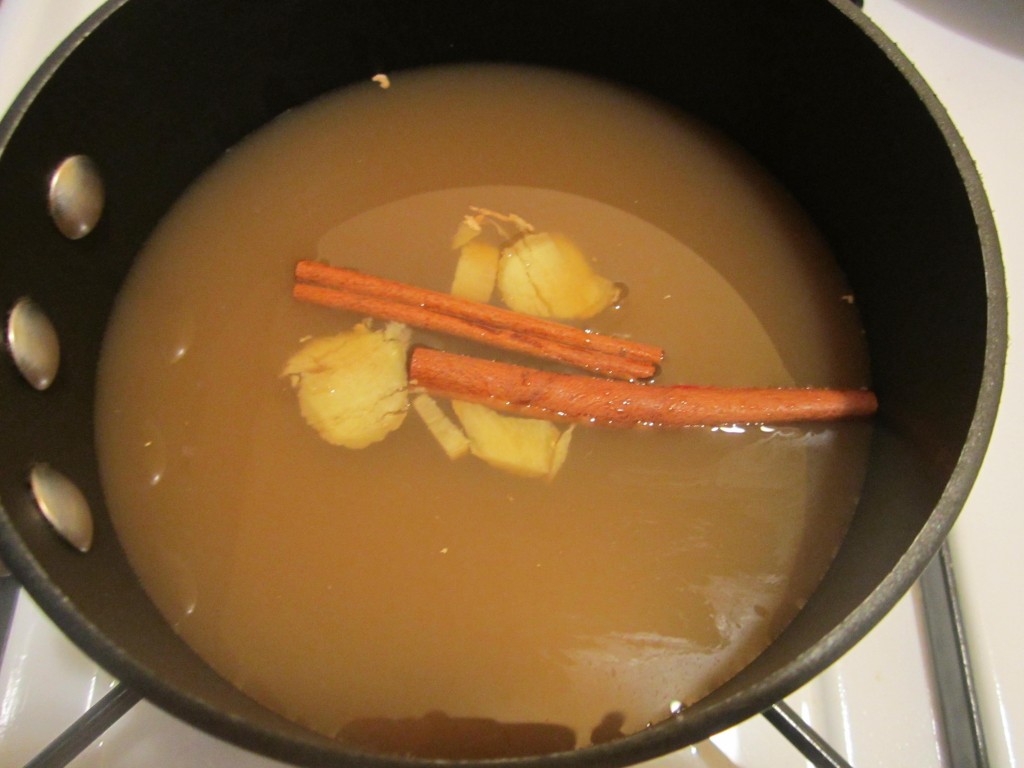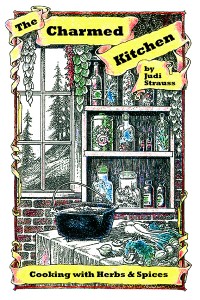Wine Jelly
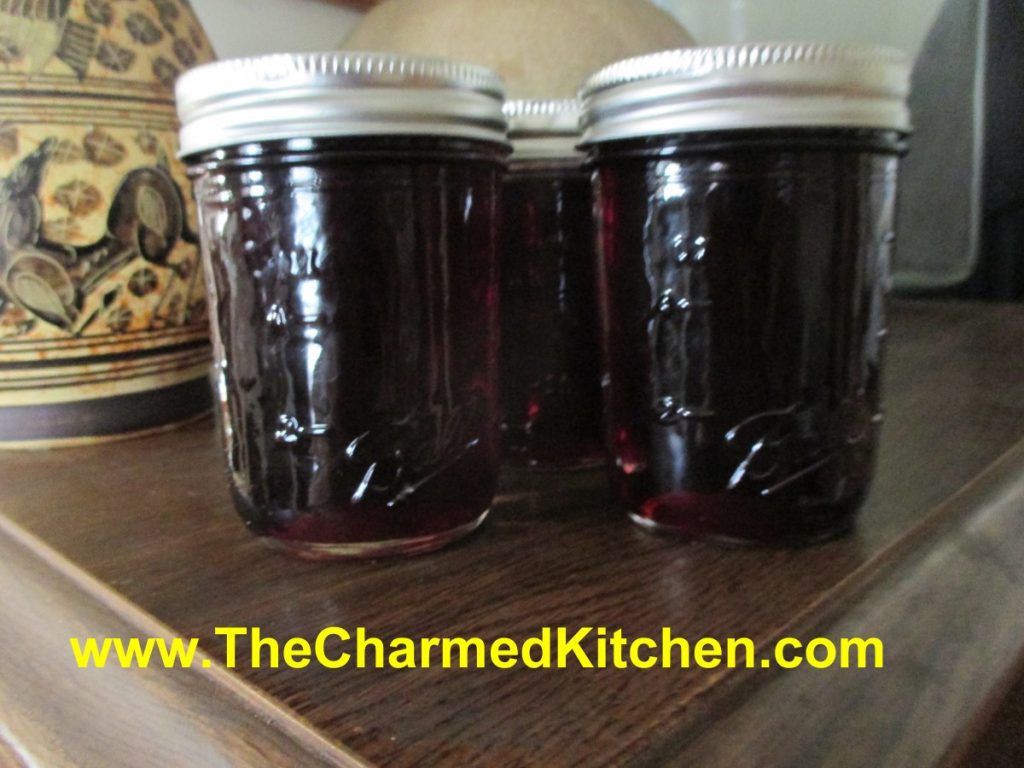
I decided it was a good day to make some wine jelly. I have to say, all that wine simmering in a pot, makes the house smell very nice. I will make several batches, some red (Merlot) and some white (Chardonnay). I might even have time to make a blush wine jelly. Any wine that is good enough to drink, can be turned into wine jelly. Having said that, I would not recommend using a really expensive wine for jelly making.
Wine jelly can be served on toast, or with bagels and cream cheese. I love it on a croissant with a little butter, or served with cheese and crackers. You can use the wine jelly to glaze meats. I have been known to use wine jelly in my thumbprint cookies, too. It always makes a nice gift.
Wine Jelly
5 c. wine
1 box (1.75oz.) pectin
7 c. sugar
Wash jars and lids and keep jars warm. I just fill them with hot water. You can also run them through a dishwasher and keep them in there until ready to use. Get a water bath canner filled with enough water to cover the jars by an inch or two of water. Bring water to a boil. Meanwhile, in large put combine wine with pectin. Cook over high heat, stirring often until mixture reaches a boil that cannot be stirred down. Boil 1 minute. Add sugar, continue stirring, and return mixture to a boil that cannot be stirred down. Boil 1 minute. Skim off any foam. Ladle jelly into hot jars, filling leaving ¼ inch headspace. Wipe rims and screw on lids comfortably tight. Place jars in water bath. Return water to boil and start timing. Process 10 minutes, then remove jars to towel covered counter top to cool. Check lids the next morning to make sure they all sealed. Makes 8-9 half-pint jars.
Note: To reduce foaming you can add one teaspoon of butter to the wine and pectin in the beginning of the cooking process.
Cooking with Honey
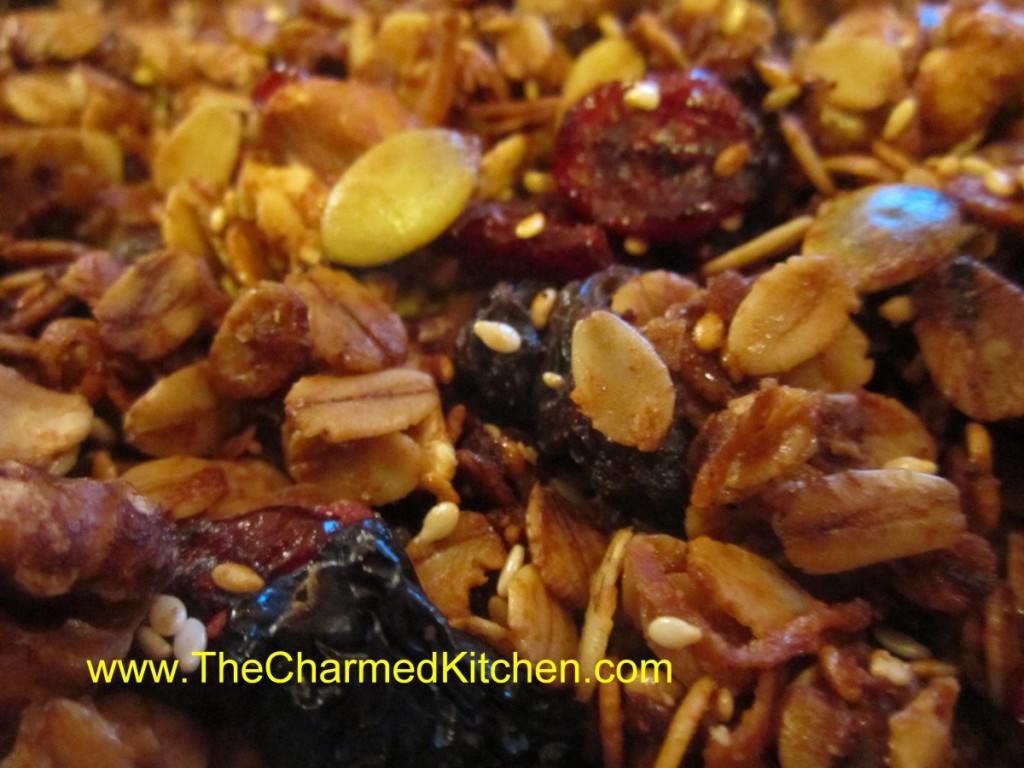
Honey has been a favorite sweetener since prehistoric times and still has advantages over sugar even today. Honey is composed of two simple sugars, glucose and fructose. Honey is absorbed in a different manner and therefore causes a slower, more gradual rise in blood sugar. Because honey has a slightly higher percentage of fructose than sugar, it tastes sweeter, and less is required for equal sweetness.
Honey contains small amounts of numerous vitamins and minerals, but not enough to fulfill any of the body’s daily needs. Remember that honey does contain calories, cannot be used freely by a diabetic and is not recommended for infant formulas.
The flavor, aroma and color of honey vary with the kind of flowers from which the bees gather the nectar used to make the honey. The fructose gives honey its sweet flavor, and the nectar adds the characteristic taste of the floral source to your recipes. Generally, the lighter the honey, the milder the flavor. If a stronger flavor is desired for your recipe, use a darker, stronger flavored honey; if a more delicate flavor is desired, use a lighter, milder flavored honey.
Honey can easily be substituted for sugar. Due to honey’s ability to retain water, products made with honey tend to remain moister longer than similar products made with sugar or other sweeteners.
Some minor adjustments may need to be made to a recipe when substituting honey for sugar:
- Use equal amounts of honey for sugar up to one cup. Over one cup, replace each cup of sugar with 2/3 to 3/4 cup over honey depending upon the sweetness desired.
- Lower the baking temperature 25 degrees and watch your time carefully since products with honey brown faster.
- In recipes using more than one cup honey for sugar, it may be necessary to reduce liquids by 1/4 cup per cup of honey.
- In baked goods, add 1/4 teaspoon of baking soda per cup of honey if baking soda is not already included in the recipe. This will reduce the acidity of the honey, as well as increase the volume of your product.
Moisten a measuring spoon or cup first with water, oil, or an egg before measuring the honey to prevent it from sticking to the measuring utensil. Honey is heavy by weight. A 12 ounce jar equals one standard 8 ounce cup. A quart weighs 3 pounds.
Honey Date Nut Bread
3/4 c. boiling water
1 c. pitted whole dates, chopped
1 egg
1 c. honey
1 T. butter, melted
1 t. vanilla
2 c. flour
1 t. baking soda
1/2 t. salt
1 c. chopped nuts
In small bowl pour water over dates and let stand until cool. Do not drain. You can do this early in the day or day ahead and refrigerate until ready to use. In small bowl beat eggs until lemon-colored, about 2 minutes. Beat in honey, butter and vanilla. Stir in dates and water. Combine dry ingredients and add to batter until smooth. Stir in nuts. Pour batter into 2 7×3-inch greased loaf pans or 1 9×5-inch greased loaf pan. Bake in preheated 350-degree oven 50 minutes for small pans and 65 minutes for large. Test for doneness with a toothpick. Cool in pan 10 minutes then turn out of pan and cool on wire rack. Makes 2 small or 1 large loaf.
Honey Cake
1 3/4 c. flour
1 t. cinnamon
3/4 t. each baking soda and salt
1/2 t. ground ginger
1 c. honey
2/3 c. oil
1/2 c. strongly brewed fresh coffee
2 large eggs
1/4 c. packed brown sugar
1T. whiskey or Bourbon
Preheat oven to 350. Grease a 9×5-inch loaf pan and set aside. Whisk together dry ingredients and set aside. Whisk together the honey, oil and coffee and set aside. In mixing bowl beat eggs and brown sugar together for 3 minutes. Beat in honey mixture and whiskey until well blended, about 1 minute. Using a rubber scraper stir in flour mixture until just combined. Pour batter into prepared pan and bake 30 minutes. Cover pan with foil and continue baking until cake starts to pull away from the sides of the pan and wooden pick inserted in center comes out clean about another 30 minutes. Cool on a rack for 1 hour before running a knife around the sides of the cake to loosen. Invert onto a rack then place upright to continue cooling. Serves 8-10.
Honey Saves the Day
When you are melting chocolate, it will sometimes seize. This normally happens when liquid gets in the melted chocolate. That’s why you have to be careful when using a double boiler. A few drops of water can spell disaster. It becomes grainy and hard and usually just gets tossed out. But, if you add a little honey to the chocolate and stir it in gently the chocolate softens and can still be used!!!!
Mom’s Cold Remedy
When I was a kid I remember my mother making her all-purpose combination for making her feel better, if she had a cold or sore throat. She would mix equal parts of honey, whiskey and lemon juice. She said the secret was just to take small sips throughout the day. Not sure if it really helped, but you certainly felt better if you sipped it all day!! For a non-alcohol version try equal parts honey, lemon juice and apple cider vinegar.
Homemade Granola
3 c. rolled oats
1/4 -1/2 c. each of any of the following to equal 1-2 c. total
Sesame seeds, sunflower seeds, chia seeds, wheat germ, peanuts, pecans, almonds, hazel nuts, pumpkin seeds, walnuts, coconut… you get the idea. Don’t forget to chop up any big pieces.
1 t. cinnamon
1 t. orange peel
1/2 t. nutmeg
pinch of salt, optional
1/4 c. oil
1/4 c. honey- or add a little more if you like a sweeter granola
2 t. vanilla
Dried fruit to equal 1 -1 1/2 cups. Some choices could include: raisins, dried cranberries, cherries, pineapple, dates, figs, apricots, bananas, blueberries etc.
In large bowl combine oats with seeds and nuts and toss well with seasonings. Heat together oil, honey and vanilla and pour over oat mixture, tossing to coat evenly. Spread on a cookie sheet and bake in a 300-degree oven for 30 minutes. Halfway through the baking time stir mixture so the edges won’t burn. Remove from oven and return to large bowl. Toss with the dried fruit and allow to cool before storing in an airtight container in a cool, dry place. Use in 1 month or store in freezer or fridge to keep longer. Makes 5-7 cups.
Honey Ginger Cough Drops
½ c. honey
2 T. lemon juice
1 t. freshly grated ginger root
Optional for dusting: ¼ cup powdered sugar and 1 t. powdered vitamin C
Kitchen items you will need: a candy thermometer, a candy mold with small openings. You can make the cough drops without the mold; oil a piece of parchment paper and pour the candy onto it. Let it harden, and then break it up into small pieces.
Measure the honey, lemon juice, and grated ginger and pour it all into a saucepan.
With a wire whisk, stir the mixture as it heats to a boil. It will become foamy and start to climb up the sides of the pan, remove it from the heat and continue to whisk it until the foam reduces and then put it back over the heat. Repeat this until a candy thermometer reads 300 degrees. You will want to check frequently because the honey heats fast and scorches easily!
If you don’t have a candy thermometer, you can also test for readiness this way. Drop a bit of the mixture into a glass of ice water (or, dip a spoon into the mixture and then quickly dip it into the ice water). If the mixture forms a hard, crunchy ball, it’s ready! If not, keep up with the whisking and heating and try again in a minute or so. Once a hard ball forms in the ice water, you’re good to go!
Let the mixture cool until the foam has reduced. Then, very carefully, drizzle the candy into the mold (or onto the oiled parchment paper). Let it cool at room temp until the cough drops are hard. When they are hard, press on the back of the mold to release. Or, if you’re not using a mold, break the cough drops up into pieces.
Optional (to prevent sticking): In a small bowl, mix the powdered sugar with the vitamin C powder. Drop the finished cough drops into the mixture to coat. Pour the sugar and cough drops into a sieve and sift to remove extra sugar. Store in an airtight container. These actually do better in the fridge, as they attract moisture and tend to get sticky if left out.
Coconut Pumpkin Bread
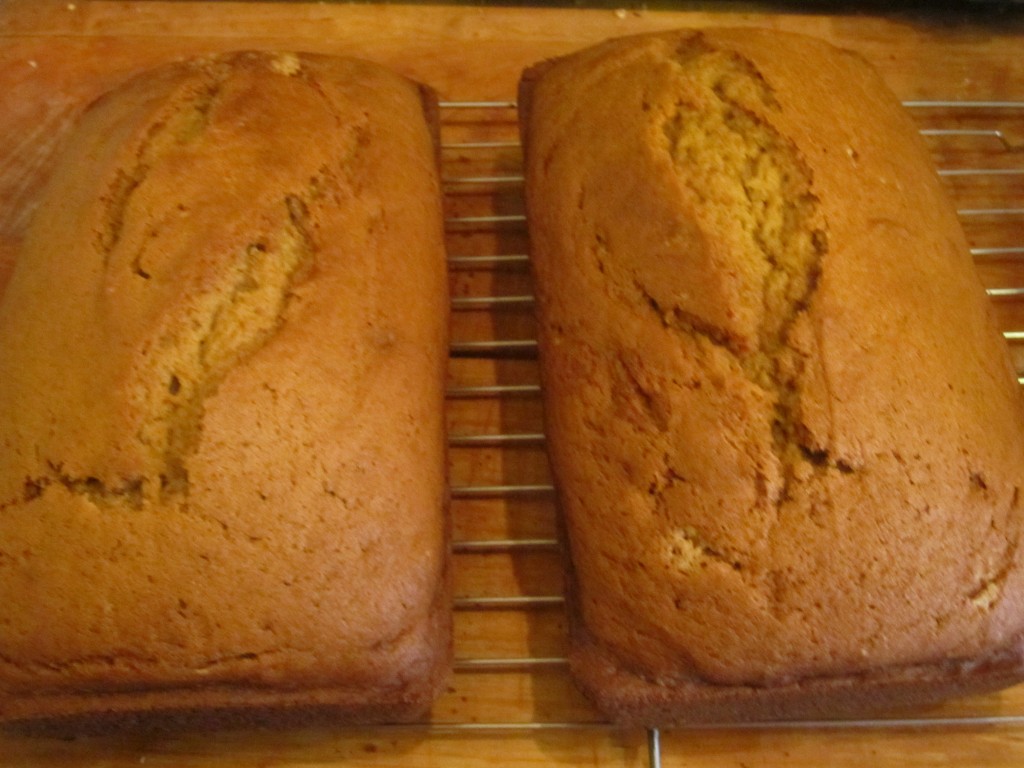
This is one of my favorite quick breads. I often make it with butternut or Hubbard squash, instead of the pumpkin. For some reason, squash bread does not sound as fun as pumpkin bread. I like to make several batches at a time, and freeze the extra. Of course, if word gets out that I have freshly baked pumpkin bread, it never makes it to the freezer. Every year I get a lot of requests. Everyone seems to love it.
The recipe called for butter originally. I decided to use coconut oil as a substitute for the butter, to see if it would work out. It was just an experiment, for a friend who can’t eat dairy. She didn’t want to use shortening, which was another option. The bread came out wonderful. Very similar to the original. Can’t honestly say there is any taste difference between this and the original recipe. Maybe a slight taste of coconut, but that could just be because I know there is coconut oil in the bread.
It is a versatile bread. Served plain, it is a great breakfast. Topped with a dusting of powdered sugar or sweetened fruit and whipped cream or ice cream, it becomes dessert. I often bake smaller loaves for gift giving.
I do find myself adding more spices, sometimes. Play around to find the combination of flavors you like. I often add cloves, allspice or mace.
Coconut Pumpkin Bread
1 ¾ c. flour
1 ½ c. sugar
1 t. baking soda
¾ t. salt
1 t. each cinnamon and nutmeg
½ c. coconut oil, you could use 1 stick of softened butter
2 eggs, beaten
1 c. pumpkin puree – you can use other winter squash
1/3 c. water
Mix dry ingredients and set aside. Beat together butter and eggs until fluffy. Beat in pumpkin and water until smooth. Stir in dry ingredients until smooth. Pour into a greased 9×5-inch loaf pan. Bake in a preheated 350-degree oven for 60-65 minutes. Cool in pan 10 minutes before removing from pan and placing on cooling rack. Wrap in plastic, best served the next day. Freezes well. Makes 1 loaf.
As with other quick bread you can make this recipe and bake it in smaller pans for gift-size loaves. Baking temperature is the same. Time will vary, so check after 30 minutes and test for doneness as usual.
Pan de Muertos (Mexican Bread of the Dead

Halloween isn’t the only holiday this week. Many people will be celebrating Dia de los Muertos (Day of the Dead). It is a holiday to remember and honor loved ones who have passed. It traditionally runs from October 31 to November 2.
Pan de Muertos is a traditional bread made for this holiday. This is a version of that bread that is flavored with anise (or fennel) and orange. It is glazed, after baking, with an orange sauce, then sprinkled with a little extra sugar. I like to use rock sugar, which, as the name implies, is a large sugar that looks like small rocks.
I shaped the dough into a round shape, with a knob of dough on the top. You can also mold the bread into different shapes like angels or animals.
The bread itself is so tasty. It is a rich dough with a lovely fragrance and texture.
Here is the recipe.
Pan de Muertos (Mexican Bread of the Dead)
1/4 c. each butter, milk and water
3 c. all-purpose flour
1 1/2 t. active dry yeast (half a packet)
1/2 t. salt
2 t. anise seed or fennel seed
1/3 c. sugar
2 eggs, beaten
2 t. orange zest
Glaze:
1/4 c. each sugar and orange juice
1 T. orange zest
Topping:
2 T. sugar, I used rock sugar
Heat together butter, water and milk until the butter melts. Cool to warm. In a large bowl combine 1cup of the flour, yeast, salt, anise seed and 1/3 c. sugar. Beat in the milk mixture then add the eggs and orange zest and beat until well combined. Stir in 1/2 cup of flour and continue adding more flour until the dough is soft. Turn the dough out onto a lightly floured surface and knead until smooth and elastic. Place the dough into a lightly greased bowl cover with plastic wrap and let rise in a warm place until doubled in size, about 1- 2 hours. Punch the dough down and shape it into a large round loaf with a round knob on top. Place dough onto a baking sheet, loosely cover with plastic wrap and let rise in a warm place for about 1 hour or until just about doubled in size. Bake in a preheated 350-degree oven for about 35 to 45 minutes. Cool on rack 5 minutes then brush with glaze. To make glaze: In a small saucepan combine the 1/4 cup sugar, orange juice and orange zest. Bring to a boil over medium heat and boil for 2 minutes. Brush over top of bread while still warm. Sprinkle glazed bread with 2 T. sugar.
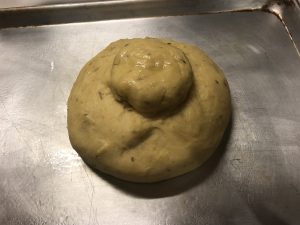
Ready to bake
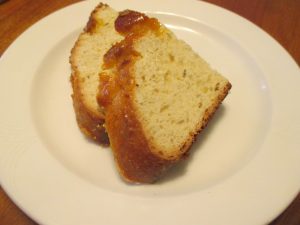
Eat plain, or lightly toasted with butter
Maple Bacon Doughnuts
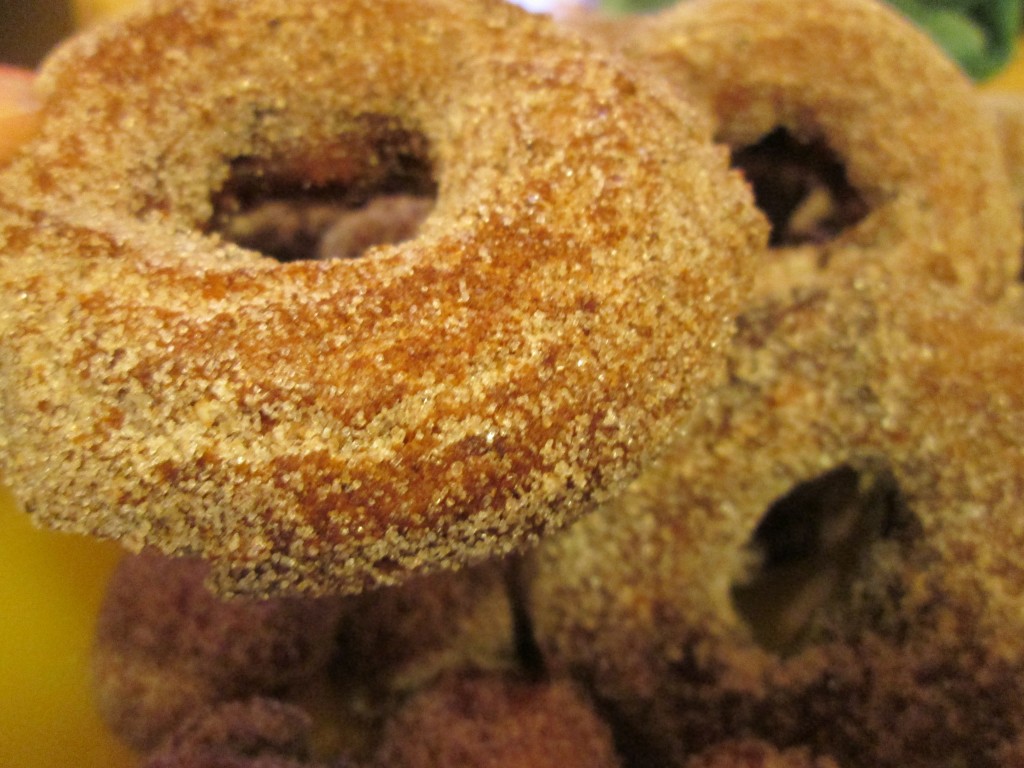
If you want homemade doughnuts, you can’t much easier than these Maple Bacon Doughnuts. They are a cake-style doughnut. That means baking powder is used to leaven the doughnuts, not yeast. You can mix up a batch of dough in just a few minutes.
You do need to let the dough chill before frying, so allow time for that.
The sweetness from the maple syrup pairs so well with the smoky bacon. Once the doughnuts are fried, I like to roll them in cinnamon sugar, but you can dust them with powdered sugar, or even make a powdered sugar glaze.
Maple Bacon Doughnuts
3 c. flour
1 T. baking powder
2 t. cinnamon
1 t. salt
1/2 t. grated ginger
2 eggs
1/2 c. sugar
1/2 c. maple syrup
1/3 c. buttermilk
1/4 c. melted butter
1 c. cooked, crumbled bacon
oil for deep frying
cinnamon sugar
Combine dry ingredients and set aside. In another bowl beat together eggs, sugar and syrup until well mixed. Stir in buttermilk and butter then stir in dry ingredients and bacon. Do not over mix. Chill dough at least a couple of hours before using it. Overnight is better. When ready to use, heat oil to 375 degrees. While oil is heating roll dough out, on a floured surface, 1/2 inch thick, and cut out with a doughnut cutter. Fry several at a time for 1 minute per side. Drain on paper towels. Roll warm doughnuts in cinnamon sugar. Re-roll scraps. You will end up with about 18 doughnuts and 18 doughnut holes
Dukkah – a Taste of Egypt
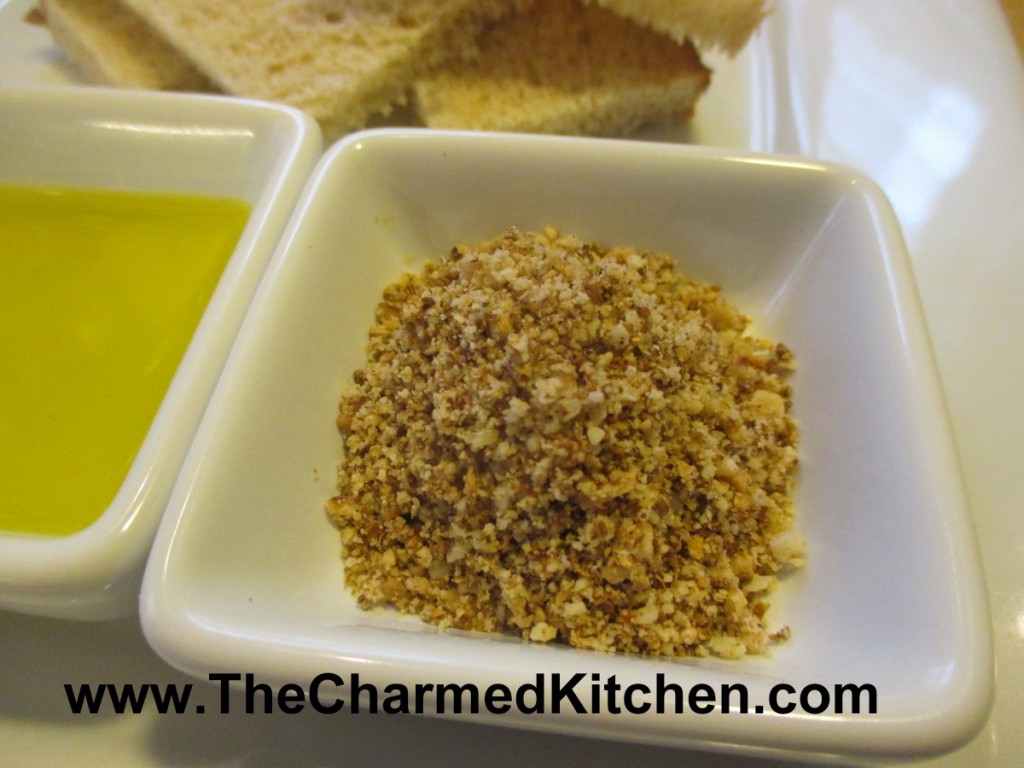
Dukkah is an Egyptian dish that is a mix of toasted nuts and spices. It has a wonderful fragrance and crunchy texture. A lot of the flavor comes from toasting the nuts and spices before grinding them up. Toasting really brings out the flavor of both the nuts and the other ingredients.
Dukkah is traditionally served with olive oil and bread. You put some in a little bowl, and put olive oil in another little bowl. Dip your bread in the oil and then in the dukkah. I like to sprinkle it on fish or chicken before baking. Dukkah is also good tossed with cooked veggies, or sprinkled on an omelet. So simple and so tasty.
Dukkah
¾ c. each whole, blanched almonds and hazelnuts
½ c. (scant) coriander seeds
¼ c. cumin seeds
6 T. sesame seeds
In 300-degree oven toast nuts for about 20 minutes or until golden. Bake cumin and coriander seeds, stirring occasionally, for about 10 minutes or until you can smell them. Toast sesame seeds for about 5 minutes. Cool all ingredients. If you prefer, you can toast the seeds in a skillet, over medium heat. Just place the coriander and cumin seeds in a skillet and heat, stirring often, until they become fragrant, about 5 minutes. Add the sesame seeds and continue toasting until sesame seeds are golden brown, about 5 minutes longer. Be careful not to burn them. Grind sesame seeds and spices into a coarse powder. In processor, chop nuts fine and combine with spices. To serve dukkah: pour olive oil in a small bowl. Place crusty bread and dukkah on a plate. Dip bread in oil then in the dukkah. I also use dukkah sprinkled on chicken and fish. Store in fridge or freezer for extended freshness.
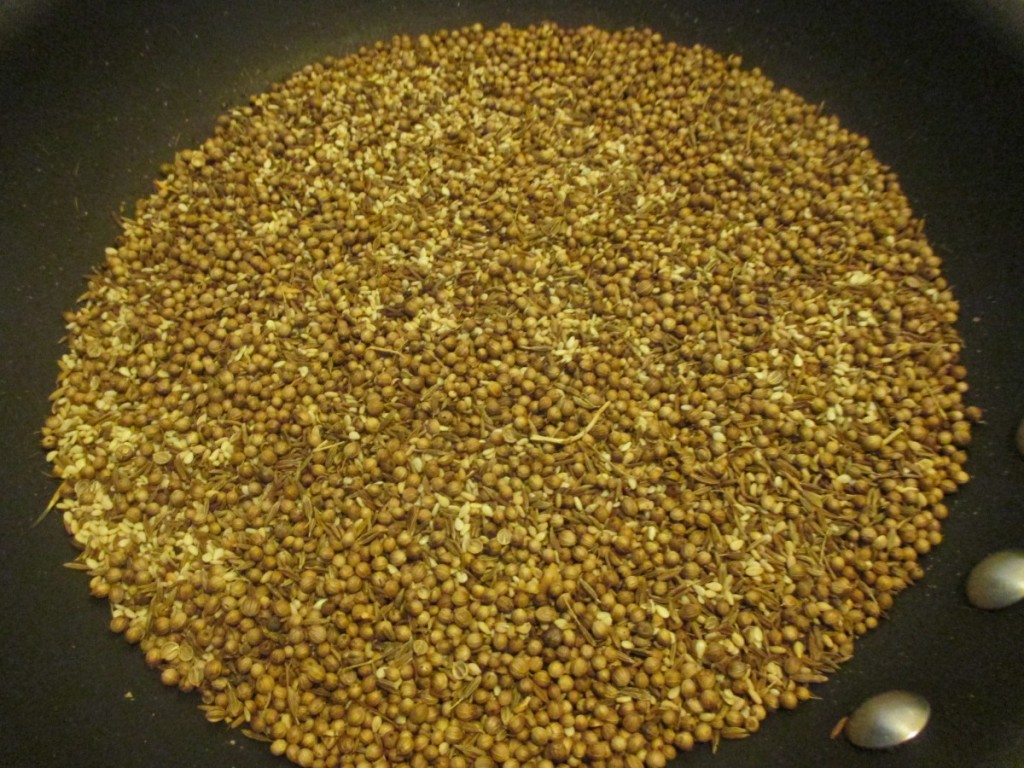
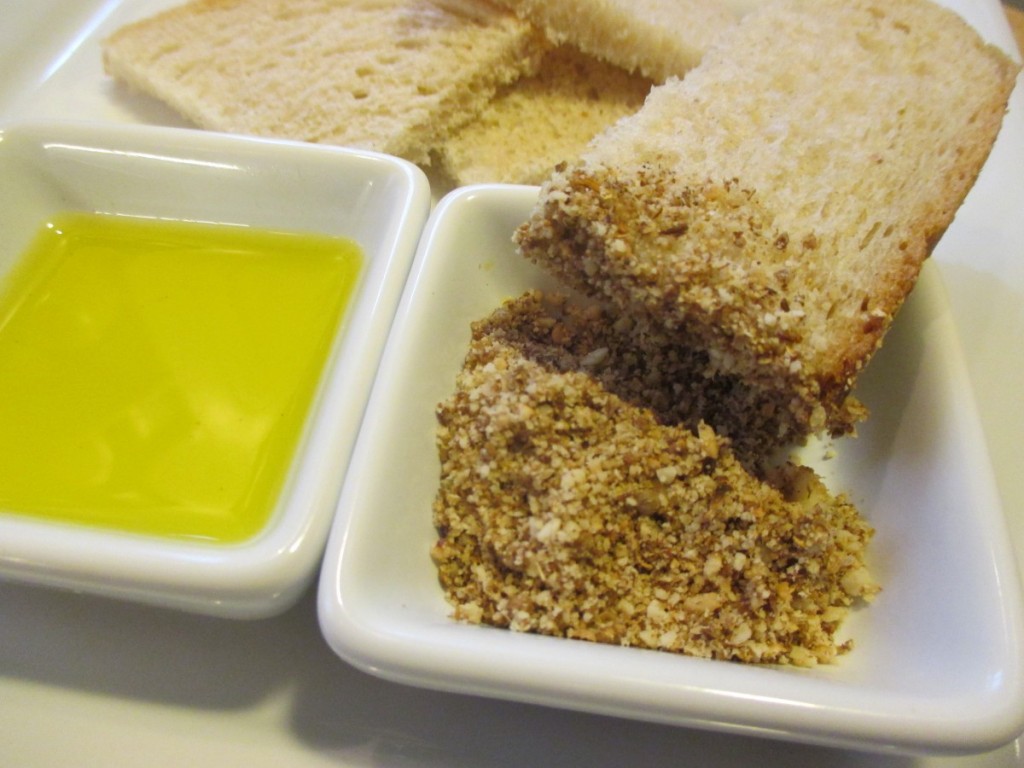
Ratatouille
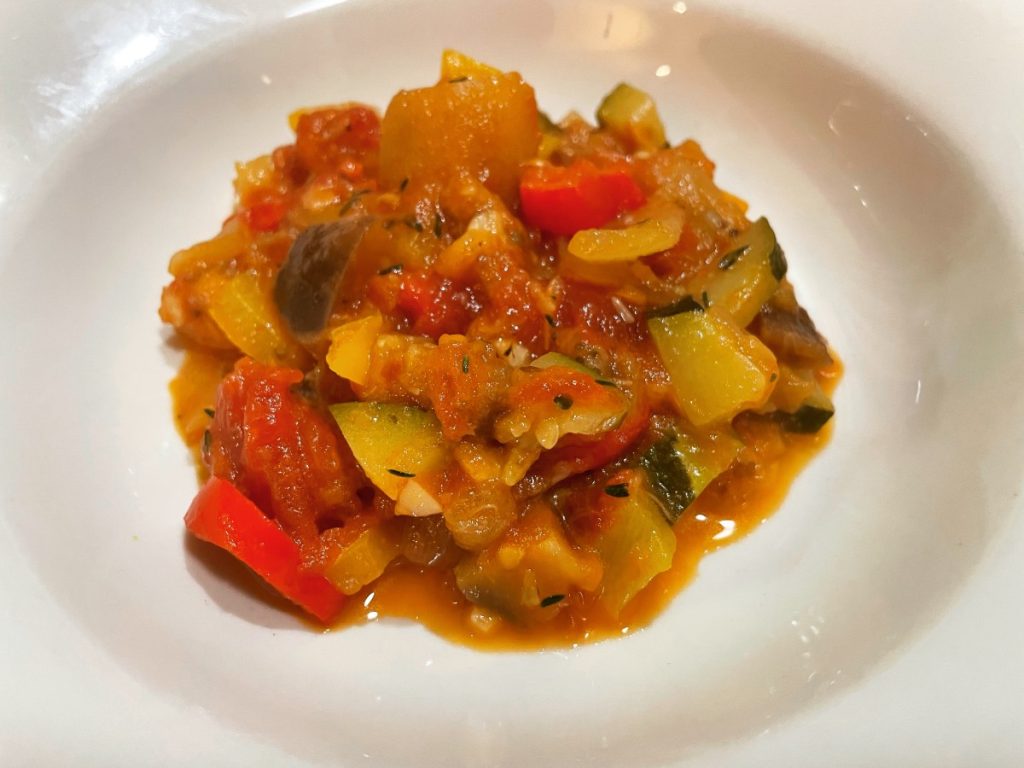
Ratatouille is a French vegetable stew made with eggplant, peppers and tomatoes, along with some other ingredients. I often enjoy it when the garden season is at its peak. For some reason I had not made it in awhile. I am not sure why not.
When a friend gave me 4 beautiful Japanese eggplant- those are the long skinny ones- I suddenly had an urge to make ratatouille. I already had peppers and zucchini. I have been canning tomatoes and I always have onions and fresh garlic.
There are all sorts of variations out there. You can adjust the herbs based on what you have and what you like. You can also play around with the ratio of the vegetables. I sometimes think of ratatouille as an end of season dish, when the last of the garden harvest is just asking to be made into a truly satisfying dish. The first time I had it a friend made it for me. We had been gardening and had a lot of veggies to use. It was so good. I have been making it ever since, although I don’t always measure everything out exactly.
So here is my recipe, the one I measured out!!
Ratatouille
1 large onion, sliced in thin wedges
2 cloves garlic, minced
3 T. oil
1 14 oz. can tomatoes, cut up, I used a pint of home canned tomatoes
1 1/2 t. dried thyme
1 t. salt
1/2 t. pepper
1 bay leaf
2 medium eggplant, peeled and cubed I used 4 Japanese eggplant, which are long and thin
2 medium zucchini, cut in chunks
2 sweet peppers, any color, seeded and chopped
Heat oil in Dutch oven and cook onion and garlic until tender. Add remaining ingredients, except peppers, and cook until vegetables are tender and sauce is thickened, about 30 minutes. If stew is too runny, remove lid and cook 10 minutes longer. Add peppers and cook, covered 15 minutes. Remove bay leaf. Serves 8-10. In crock-pot combine all ingredients and cook on low 6-8 hours.
Spatchcock!!!

This funny sounding word is actually a method of cutting and cooking chickens and other poultry. While there is no hard evidence of who first used the term, it is believed to have originated in the 17th century and meant “dispatching the cock” or killing the chicken.
Today, spatchcock just means to remove the backbone of the bird and then to press down on the breast bone to flatten it out a bit. This helps the bird to cook faster, more evenly and to have crisper skin. I have spatchcocked dozens of chickens and am very pleased with the results. People I know who have spatchcocked a turkey swear by it as a method of cooking the turkey faster and more evenly.
Perhaps this year I will Spatchcock my turkey.
So where do you start?
I normally use kitchen shears and sometimes a sharp boning knife. Place the bird breast side down on your work surface. Just off center, use your kitchen scissors to cut out the center of the back. The piece you remove from the chicken should be a little more than an inch wide. I often cut it out in a couple of pieces. The part removed can be used to make stock.
Next turn the bird over and press down on the breast until you feel the breast bone break. It’s pretty subtle and you aren’t looking to flatten the bird, just to get the breast to rest on the surface.
Note: I have cooked my chicken without pressing down on the breast bone first and it cooked fine. It just seems to be a little more traditional to press it down and to get better contact with the baking pan.
Next, transfer your chicken, or other poultry, to a baking pan with a rack in it. Season to your taste. I use salt, pepper and often my Ethiopian seasoning blend- recipe follows. Place in a preheated 375 degree oven and roast until the internal temperature of the chicken reaches 165 degrees. Use an instant read thermometer to check. You can also test by piercing the chicken where the meat is thickest and see if the juices run out clear (chicken is cooked) or pinkish (chicken needs more time).
How long with it take? I wish I had an exact answer for you. It seems to take around an hour and 15 minutes most times, but ovens vary and so does the size of the bird. If the bird is getting done too quickly for your plans, you can turn the oven down to 325.
Once the chicken is done, remove from the oven and allow it to rest 15-20 minutes, then carve and serve. I have had people say they don’t get drippings when they spatchcock. I have not found this to be the case. Maybe not as many, but you can still deglaze the pan and make gravy when you spatchcock a chicken.
Ethiopian Seasoning
1 T. paprika
1 t. each cayenne pepper, cumin, garlic powder and ginger
1/2 t. allspice
1/4 t. cinnamon
Combine all ingredients. Store in fridge.
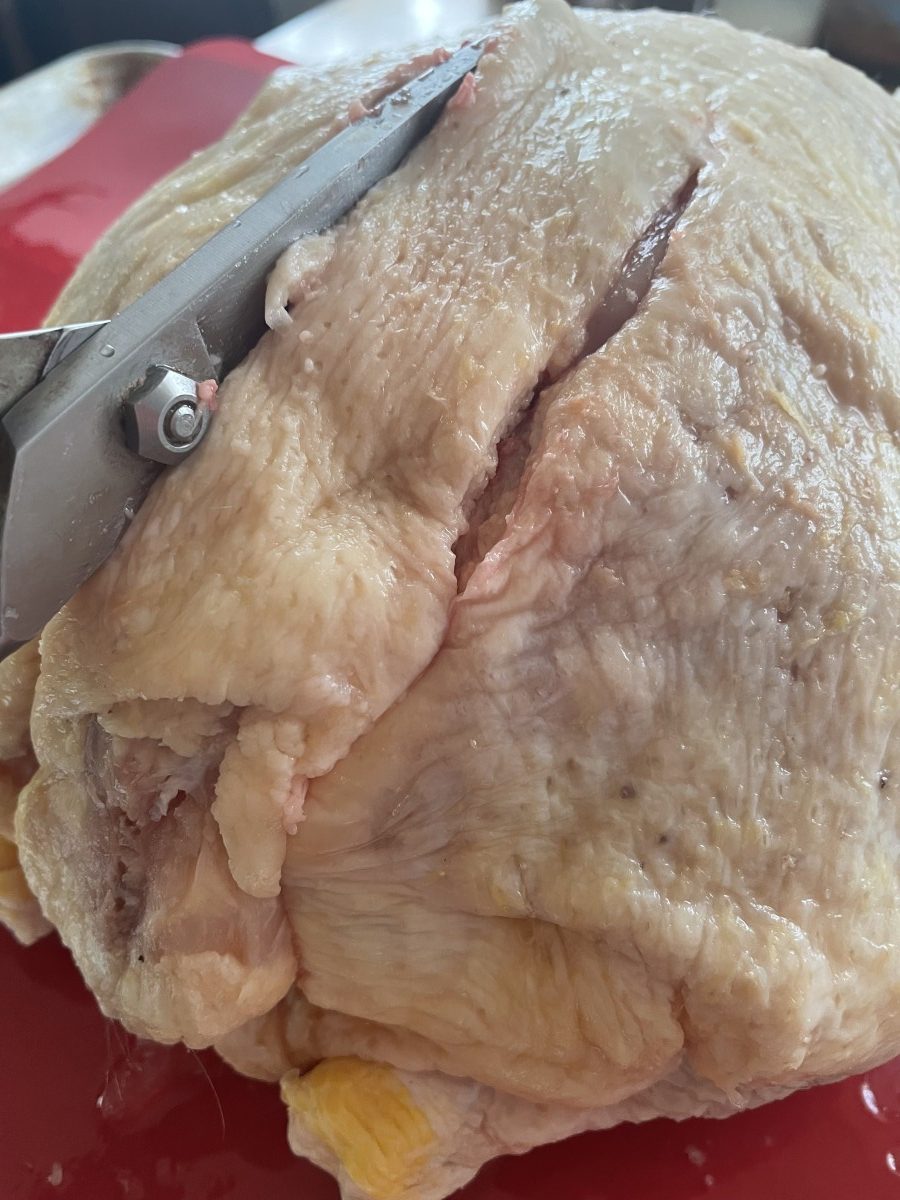
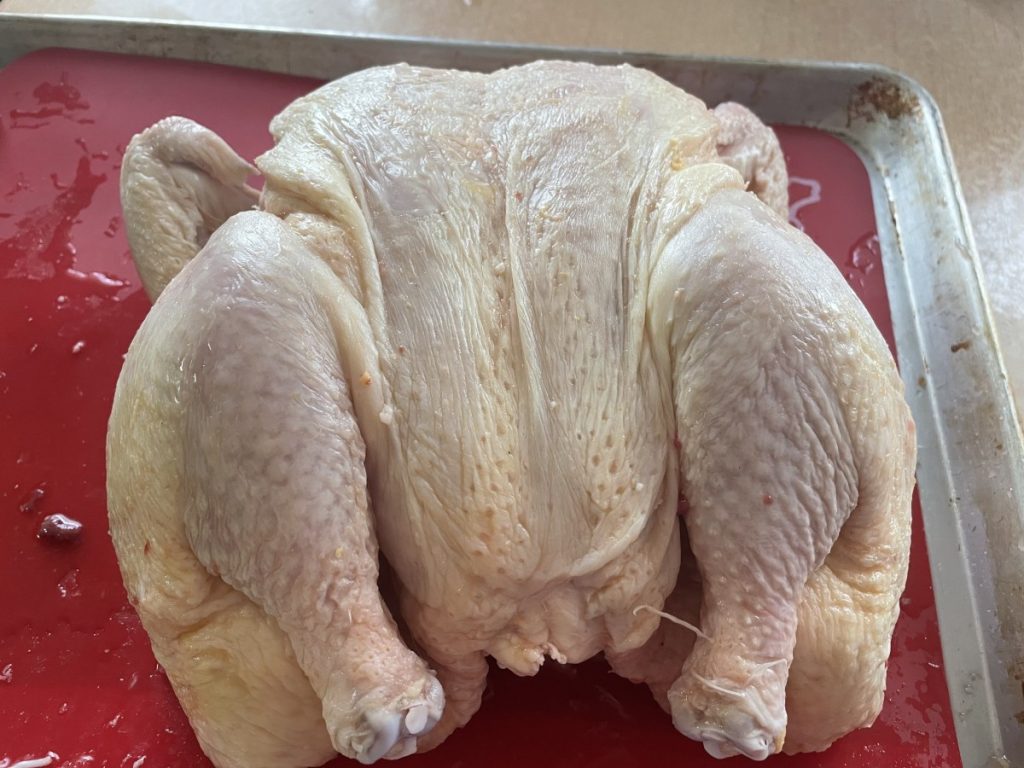
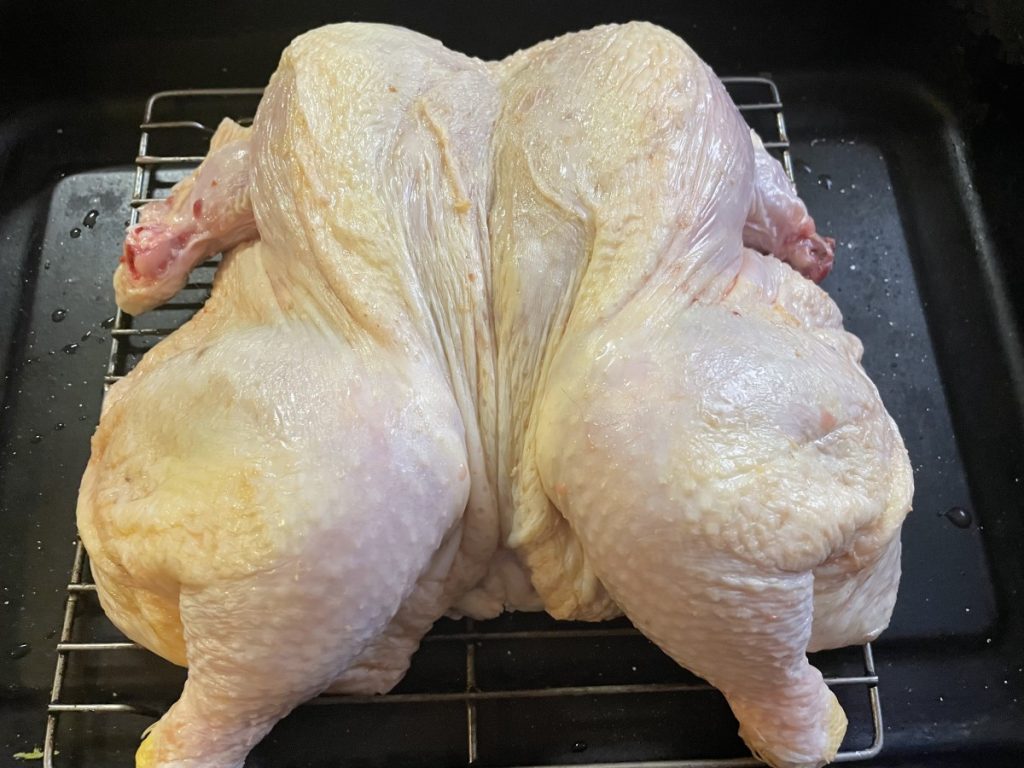
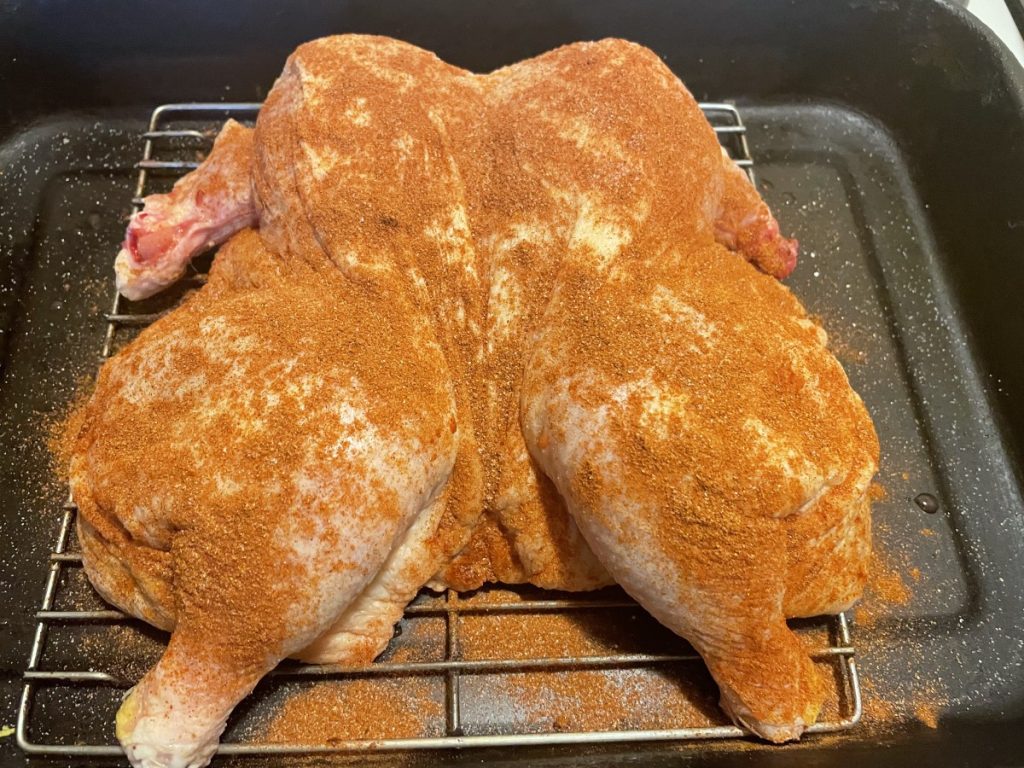
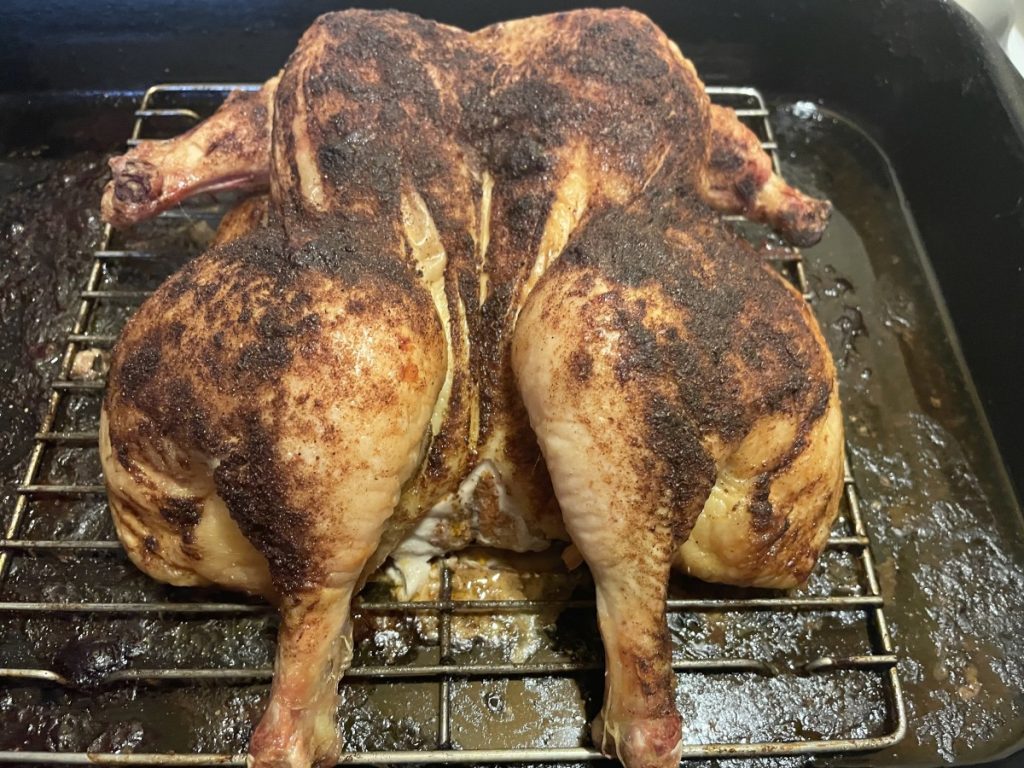
Spanish Rice
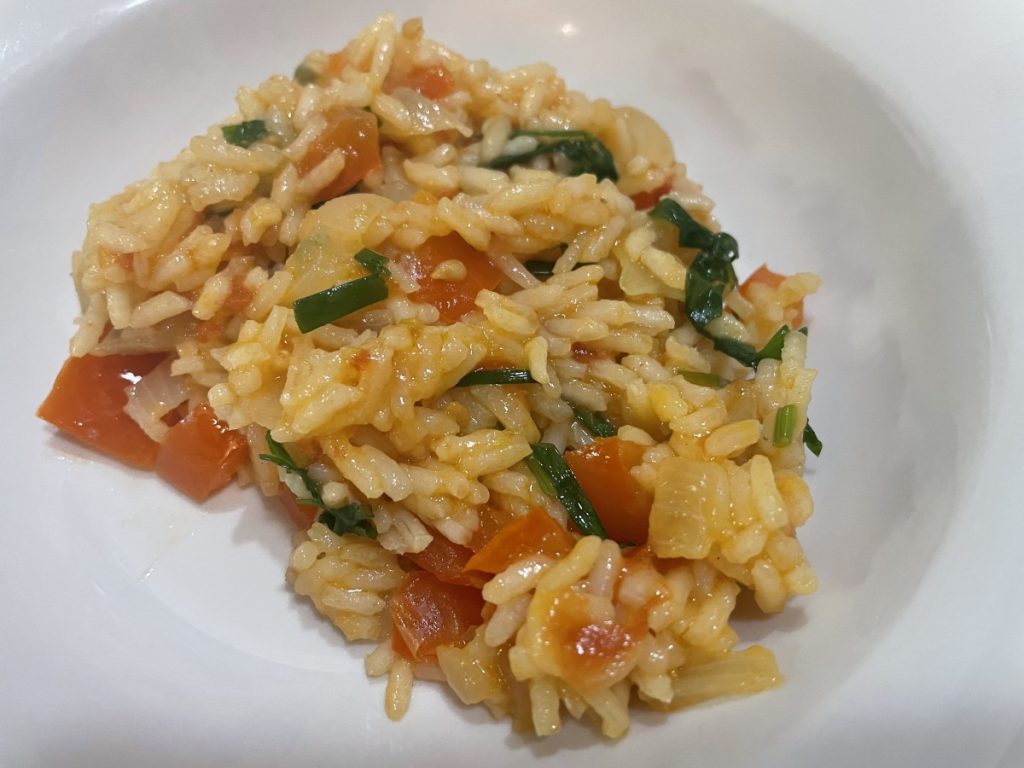
One of my favorite rice dishes is Spanish Rice. When I was a kid my Mom would make it as a side dish for roasted chicken or pork chops. The addition of peppers and tomatoes elevates humble rice in a simple and tasty way. I canned a lot of tomatoes, so using them in more dishes is always a good thing.
It can be made with or without bacon. For a dinner over the weekend with friends I opted not to add the bacon. The bacon does add that smoky flavor we like so much. Even if you opt to leave the bacon out, this classic dish is always a hit.
Spanish Rice
1 lb. bacon, chopped up or 3 T. oil
1½ c. long grain rice – I used Jasmine rice*
1 onion, chopped
2 sweet peppers, any color, seeded and chopped
2 c. chicken stock, vegetable stock or water
1 (14 oz.) can whole tomatoes, cut up – I used a pint of home canned tomatoes
2 T. fresh chopped parsley
1 T. chopped fresh chives, optional, or green onion
salt and pepper to taste
Cook bacon in skillet. Spoon out all but a couple of tablespoons of the fat. If using oil instead of bacon, just heat the oil in the skillet and add the onion and rice. Add rice and onion to bacon, cooking until onions are tender. Add remaining ingredients and simmer, covered until rice is cooked, about 20 minutes. Makes 5 cups.
* When using a brown rice cooking time will increase to about 40 minutes. You might need a little more
Ginger Cinnamon Cider

It’s chilly today, and I love a mug of hot apple cider to warm up. I wanted to spice it up a little. I ended up adding sliced ginger and a cinnamon stick and the result was really good.
I always keep ginger root in my freezer. It is frustrating to buy a piece of ginger and then find it in the bottom of the crisper drawer weeks later looking like a science experiment gone bad. Freezing it solves that problem. When I want to use it, I just take it out of the freezer, scrape off the peel and grate or slice off what I need. It keeps pretty much forever that way, and I have “fresh” ginger whenever the mood strikes me. You can also finish the cider off with a splash of brandy just before serving.
Ginger Cinnamon Cider
2 cups apple cider
1-inch piece of ginger, sliced
1 cinnamon stick, broken in half
Place cider in a saucepan with the ginger and cinnamon. Simmer gently for 5 minutes- or a little longer if you want a more intense ginger taste. Strain and serve. Serves 2.
Note: Some of the cider will boil off so add a little more if you simmer it longer or keep the pot covered to reduce evaporation. I actually like the more intense flavor when it cooks down a little.
